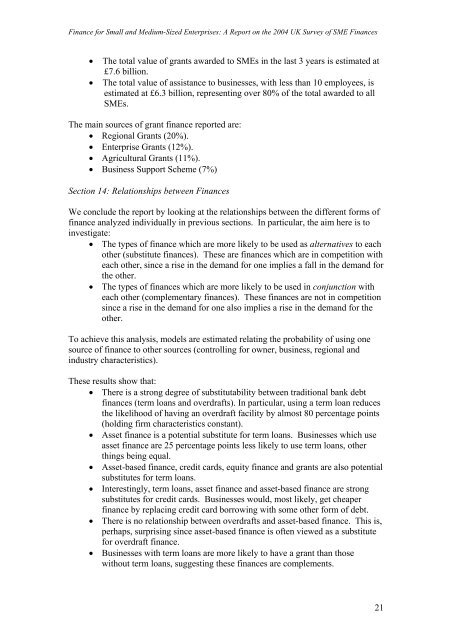Finance for Small and Medium-Sized Enterprises - DTI Home Page
Finance for Small and Medium-Sized Enterprises - DTI Home Page
Finance for Small and Medium-Sized Enterprises - DTI Home Page
Create successful ePaper yourself
Turn your PDF publications into a flip-book with our unique Google optimized e-Paper software.
<strong>Finance</strong> <strong>for</strong> <strong>Small</strong> <strong>and</strong> <strong>Medium</strong>-<strong>Sized</strong> <strong>Enterprises</strong>: A Report on the 2004 UK Survey of SME <strong>Finance</strong>s<br />
• The total value of grants awarded to SMEs in the last 3 years is estimated at<br />
£7.6 billion.<br />
• The total value of assistance to businesses, with less than 10 employees, is<br />
estimated at £6.3 billion, representing over 80% of the total awarded to all<br />
SMEs.<br />
The main sources of grant finance reported are:<br />
• Regional Grants (20%).<br />
• Enterprise Grants (12%).<br />
• Agricultural Grants (11%).<br />
• Business Support Scheme (7%)<br />
Section 14: Relationships between <strong>Finance</strong>s<br />
We conclude the report by looking at the relationships between the different <strong>for</strong>ms of<br />
finance analyzed individually in previous sections. In particular, the aim here is to<br />
investigate:<br />
• The types of finance which are more likely to be used as alternatives to each<br />
other (substitute finances). These are finances which are in competition with<br />
each other, since a rise in the dem<strong>and</strong> <strong>for</strong> one implies a fall in the dem<strong>and</strong> <strong>for</strong><br />
the other.<br />
• The types of finances which are more likely to be used in conjunction with<br />
each other (complementary finances). These finances are not in competition<br />
since a rise in the dem<strong>and</strong> <strong>for</strong> one also implies a rise in the dem<strong>and</strong> <strong>for</strong> the<br />
other.<br />
To achieve this analysis, models are estimated relating the probability of using one<br />
source of finance to other sources (controlling <strong>for</strong> owner, business, regional <strong>and</strong><br />
industry characteristics).<br />
These results show that:<br />
• There is a strong degree of substitutability between traditional bank debt<br />
finances (term loans <strong>and</strong> overdrafts). In particular, using a term loan reduces<br />
the likelihood of having an overdraft facility by almost 80 percentage points<br />
(holding firm characteristics constant).<br />
• Asset finance is a potential substitute <strong>for</strong> term loans. Businesses which use<br />
asset finance are 25 percentage points less likely to use term loans, other<br />
things being equal.<br />
• Asset-based finance, credit cards, equity finance <strong>and</strong> grants are also potential<br />
substitutes <strong>for</strong> term loans.<br />
• Interestingly, term loans, asset finance <strong>and</strong> asset-based finance are strong<br />
substitutes <strong>for</strong> credit cards. Businesses would, most likely, get cheaper<br />
finance by replacing credit card borrowing with some other <strong>for</strong>m of debt.<br />
• There is no relationship between overdrafts <strong>and</strong> asset-based finance. This is,<br />
perhaps, surprising since asset-based finance is often viewed as a substitute<br />
<strong>for</strong> overdraft finance.<br />
• Businesses with term loans are more likely to have a grant than those<br />
without term loans, suggesting these finances are complements.<br />
21















![Joint Report on Social Protection and Social Inclusion [2005]](https://img.yumpu.com/19580638/1/190x132/joint-report-on-social-protection-and-social-inclusion-2005.jpg?quality=85)
